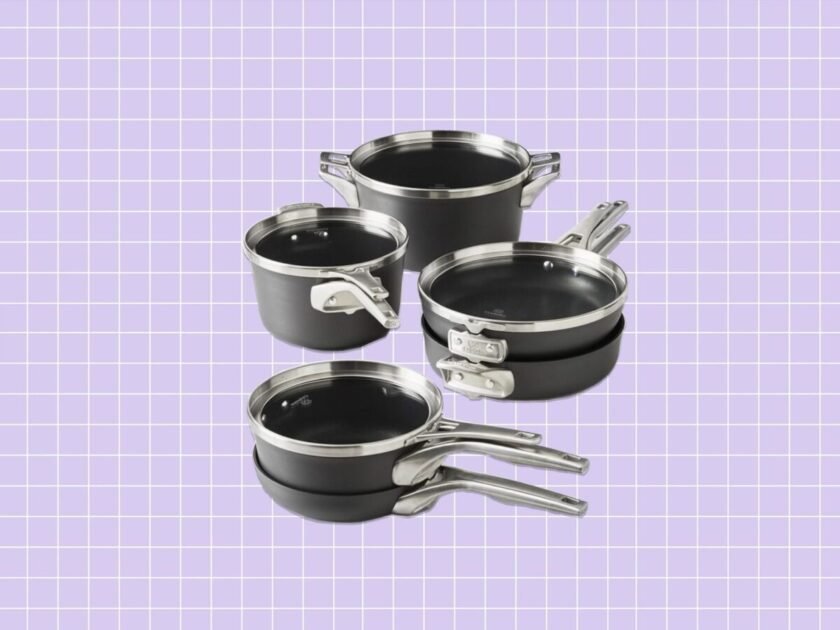Nonstick pans can be safe to use if they are treated and maintained correctly; the question of their safety lies in how they are used and cared for.
The Safety Of Non-stick Pans
Nonstick pans have become a popular choice in kitchens around the world. Their ability to prevent food from sticking and make clean-up a breeze has made them a convenient option for home cooks. However, concerns about the safety of nonstick pans have also been raised, leading to confusion among consumers. In this article, we aim to clarify the topic by separating fact from fiction. We will explore the different types of nonstick coatings, potential health risks, and safe usage and maintenance techniques to help you make an informed decision about the safety of nonstick pans.
Understanding Nonstick Coatings
Nonstick pans are typically coated with a layer of material that prevents food from sticking to the surface. The most common types of nonstick coatings are Teflon (polytetrafluoroethylene, or PTFE) and ceramic. Teflon coatings have been used for many years and are known for their excellent nonstick properties. On the other hand, ceramic coatings are a newer alternative seen as more environmentally friendly.
Both types of coatings are generally safe to use when used correctly. Teflon coatings, however, can release toxic fumes when overheated, harming humans and pets. Following the manufacturer’s instructions is important, as is avoiding exposing nonstick pans to high heat. Ceramic coatings, on the other hand, are considered to be more heat-resistant and do not release toxic fumes.
Potential Health Risks Of Nonstick Pans
There have been concerns about the potential health risks associated with using nonstick pans, particularly Teflon-coated pans. Some studies suggest that the chemicals used in producing Teflon coatings, such as perfluorooctanoic acid (PFOA), may adversely affect human health.
However, when used correctly, the U.S. Food and Drug Administration (FDA) and other regulatory bodies have deemed Teflon coatings safe for use in cookware. The key is to avoid overheating the pan, as this can cause the release of toxic fumes. It is also worth noting that using Teflon-coated pans in everyday cooking is unlikely to cause significant exposure to these chemicals. Nonetheless, individuals with respiratory conditions or birds as pets should take extra precautions when using nonstick pans.
Safe Usage And Maintenance Techniques
To ensure the safe use of nonstick pans, here are some essential tips to keep in mind:
- Avoid using nonstick pans in high-heat settings. Stick to medium-low to medium heat for best results.
- Do not use metal utensils that can scratch or damage the nonstick coating. Instead, opt for silicone, wood, or plastic utensils.
- Hand wash your nonstick pans using mild dish soap and a soft sponge. Avoid using abrasive cleaners or scouring pads, which can damage the coating.
- Regularly inspect the condition of the nonstick coating. If you notice any peeling or flaking, it is time to replace the pan.
- Store your nonstick pans properly to prevent scratches. Consider using pan protectors or stacking them with a soft cloth between each pan.
By following these safe usage and maintenance techniques, you can extend the lifespan of your nonstick pans and minimize potential health risks.
In conclusion, when used correctly, nonstick pans can be a safe and convenient addition to your kitchen. Understanding the different types of nonstick coatings, being aware of potential health risks, and implementing safe usage and maintenance techniques are essential for enjoying the benefits of nonstick pans while minimizing any associated concerns.
Debunking Common Myths
Discover the truth about nonstick pans with our myth-busting guide. Find out if they are safe to use and separate fact from fiction, providing peace of mind in your kitchen.
Nonstick
Myth: Nonstick Pans Are Always Toxic
One common myth surrounding nonstick pans is that they are always toxic. However, this is far from the truth. While some older nonstick pans use perfluorooctanoic acid (PFOA) in manufacturing, most modern nonstick pans are PFOA-free and have undergone rigorous testing to ensure their safety. The leading nonstick coating used today is made of polytetrafluoroethylene (PTFE), commonly known as Teflon. When used correctly and not overheated, PTFE-based nonstick pans are generally safe.
It’s important to note that if anonstickk pan is overheated or scratched, it may release harmful fumes. However, this occurs at extremely high temperatures that are unlikely to be reached during regular cooking. To stay safe, always follow the manufacturer’s instructions and avoid usingnonstickk pans on high heat or for searing meat.
Myth: ScratchedNonstickk Pans Are Unsafe
Another common myth is that scratchednonstickk pans are unsafe to use. While it’s true that scratches can compromise the integrity of thenonstickk coating, not all scratches are created equal. Minor surface scratches are usually harmless and won’t significantly impact the pan’snonstickk properties.
However, deep scratches or flakes of thenonstickk coating coming off should be a cause for concern. If thenonstickk coating is visibly peeling, it’s best to discontinue using the pan, as the flakes can mix with your food and potentially pose health risks. Regularly inspect yournonstickk pans for any signs of damage and replace them if necessary to ensure your safety.
Myth: Chefs AvoidNonstickk Pans For Safety Reasons
Contrary to popular belief, chefs don’t avoidnonstickk pans solely for safety reasons. While it’s true that professional kitchens often favour other types of cookware, such as stainless steel or cast iron, it’s not becausenonstickk pans are inherently unsafe.
Chefs prefer different materials for different cooking techniques. Stainless steel pans, for example, are excellent for achieving a crispy sear on proteins, while cast iron pans excel at heat retention and even heat distribution.NOnthe other hand, anon-stick pans re best suited for delicate foods like eggs and pancakes that require effortless release.
Ultimately, the choice of cookware depends on personal preference and the type of dish being prepared. Chefs value the versatility and durability of other materials, but that doesn’t meannonstickk pans can’t be safely used at home for everyday cooking.
Alternative Options And Best Practices
Regardingnonstickk pans, there has been a long-standing debate about their safety. While some believe that the chemicals used in thenonstickk coating can harm our health, others argue that, when appropriately used,nonstickk pans are perfectly safe.
Safer Alternatives To Non-Sticker Pans
If you’re concerned about the potential health risks of usingnonstickk pans, several alternative options are available. Choose cookware made from stainless steel, cast iron, or ceramic. These materials are naturallynonstickk and do not require any coatings or chemicals that could leach into your food.
ChoosingNonstickk Pans With Health In Mind
If you prefer usingnonstickk pans but still want to prioritize your health, there are some key factors to consider when selecting. Opt for pans labelled as PFOA-free, as this chemical has been linked to various health concerns. Additionally, choose pans with a ceramic-based coating instead of traditional Teflon. Ceramic coatings are considered safer as they do not release toxic fumes at high temperatures.
Proper Cooking Techniques For Non-Sticker Pans
Even if you stick withnonstickk pans, it’s crucial to use them properly to minimize potential health risks. Avoid using metal utensils that can scratch and damage thenonstickk coating. Instead, opt for silicone, wood, or nylon utensils that are gentle on the surface. Additionally, always cook on low to medium heat to prevent the release of harmful fumes.
To further protect thenonstickk coating, it’s essential to clean and care for your pans properly properly. Avoid abrasive cleaners and scrubbing pads that can damage the coating. Instead, use a soft sponge or cloth with mild soap and warm water. Finally, replace yournonstickk pans when the coating starts to peel or scratch, as this can release potentially harmful chemicals into your food.
While the safety ofnonstickk pans can be debated, understanding the alternatives and best practices can help you make informed decisions. Whether you opt for safer alternatives or stick withnonstickk pans, prioritize your health by following proper cooking techniques and maintenance.

Frequently Asked Questions On AreNonstickk Pans Safe? Separating Fact From Fiction
How Unhealthy Are Non-Stick Pans?
Non-stick pans can be unhealthy if they are scratched or peeling. The coating can flake off and get into your food, which is unappetizing. It is best to stop using anonstickk pan that is no longernonstickk. Proper usage and maintenance play a crucial role in determining the safety ofnonstickk pans.
Why Do Chefs Not Use Non-Stick Pans?
Chefs don’t usenonstickk pans because they heat up slowly, which is not ideal in a busy kitchen where quick heat transfer is crucial.
Is It Safe To Use Peeling Non-Stick Pan?
Using a peelingnonstickk pan is unsafe as the coating can flake into your food, which is unappetizing. It is recommended to stop using a pan that is no longernonstickk.
Are Non-Stick Pans Safe When Scratched?
Non-stick pans may not be safe when scratched. The scratched surface can release potentially harmful chemicals into your food.
Conclusion
Non-stick pans can be safe to use in your kitchen if they are treated and maintained correctly. Understanding the facts and separating them from fiction is crucial in making informed choices about cookware. It’s important to avoid scratching the surface with metal utensils and to replace pans with peeling coatings.
By following these guidelines, you can enjoy the benefits ofnonstickk pans without compromising your health.

Hi, I’m Esrat, and I’m so glad that you found me here at Happy Food Kitchen! I started Happy Food Kitchen in 2023 to have a creative, right-brained outlet to balance my very left-brained career in genetics.




